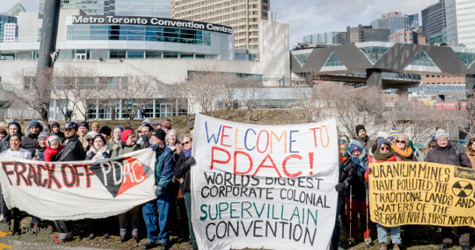Mayor’s Panel Dreams of White Shiny City by the Lake
Ten years after Toronto’s amalgamation, a new report commissioned by Mayor David Miller signals consensus among city power-brokers, local politicians (progressives, social democrats, centrists and right-wingers alike), and Premier McGuinty that the logic of the neoliberal restructuring of Toronto has triumphed. There is, apparently, no going back. The city is on its own and must shrink to greatness.
The Blueprint for Fiscal Stability and Economic Prosperity is a call to action by the mayor’s multi-partite “fiscal review panel,” struck in the autumn of 2007. A real estate executive tied to the Progressive Conservatives, Blake Hutcheson, chairs the panel, which is rounded out by former Liberal Senator and York University President Lorna Marsden, financier Paul Massara, sporting and real estate magnate Larry Tanenbaum, Toronto Community Foundation CEO and one-time VP of the Toronto Olympic Bid Committee Rahul Bhardwaj and Canadian Auto Workers economist Jim Stanford. These people represent key components of Toronto’s power block, brought together in response to the Mayor’s first major defeat on the floor of council, with the initial rejection last summer of his proposals to introduce new real estate and vehicle licensing taxes. Not only a sop to the right-wing opposition, the panel has re-established the corporate support base that Miller has been cultivating since launching his first mayoral campaign back in 2002.
The report is thin on research and substance. It makes several specific recommendations with no supporting information and is considerably less substantial even than many city staff reports. The Blueprint restates things we already know about, such as the fact that Toronto continues to shoulder the financial burden from fifteen years of downloading from provincial and federal governments. The Panel members appear to have developed a set of beliefs and convictions, turned into recommendations, based on a few visits to city departments and meetings with city officials. Ultimately, this is an exercise in propaganda and “political diplomacy,” to put it in David Nickle’s words.

With the broad acceptance of the report at the end of February, at least inside City Hall and among mainstream journalists, wholesale privatization of city institutions and services is back on the table. Cast as Toronto’s biggest residential and non-residential landlord in a war for survival of the fittest with neighbouring and international competitors, the mayor is being urged to “take on some of the sacred cows” at City Hall and make a series of major changes that would effectively end the city’s admittedly spotty history of citizen-led and movement-driven urban reform.
These changes include a formal centralization of political power inside City Hall, “marketization” of government services and assets (with the possibility of outright privatization), and the creation of a virtual competitive city-state to “take responsibility for its own destiny.”
Centralization of Power
Key to consolidating power at city hall is the formalization of the power of the executive committee. Blueprint recommends that executive committee members be appointed by the mayor and eligible for a pay premium, can meet in private and largely control the city’s political and bureaucratic agendas. The mayor and executive should hire their own professional staff, the panel adds, and the mayor should have the power to hire and fire the top city manager. These strong-mayor measures were written into the provincial City of Toronto Act passed in 2006 but rejected by Miller until just after the release of the panel report.
Accentuating one of the key features of the post-amalgamation period, the panel urges further “streamlining” of the city budget process, which would be placed even more firmly under the control of the executive as is already the case. The report also reiterates previous recommendations to move toward a “top-down rolling five-year operating budgets” (and ten-year capital budgets), thus inverting what they misleadingly suggest is a “bottom-up” approach in the current system of making budget decisions on an annual basis. The panel also believes the city’s chief financial officer should have tighter financial controls, including over the city’s agencies, boards and commissions – including the Board of Health, the TTC and the city’s newly consolidated Toronto Community Housing Company.
Taken together, the changes would effectively seal up what remains of the porous political system at city hall that still allows for rare surprises and, more importantly, influence by relatively unorganized groups of residents. Uncertainty, after all, is bad for business.
Privatization and “marketization”
The panel also proposes intensifying so-called “marketization” strategies that have long been a feature of the local state in early modern Canada, and, more recently, in newer suburban municipalities. Rather more timid in this respect than other business groups, the panel nonetheless proposes that the city “monetize” city assets. This may go as far as privatizing Toronto Hydro, the Toronto Parking Authority and Enwave. The panel recognizes that such marketization and privatization strategies require central control when it suggests that they be coordinated by senior bureaucrats responsible for infrastructure and real estate in all city departments and agencies.
As the biggest landlord in Toronto, the panel also finds the city should “unlock value” from its more than 7,000 residential and non-residential properties “conservatively valued at some $17.9 billion” by “converting inert space into revenue,” leasing instead of owning properties, selling air rights for development, and pursuing “entrepreneurial real estate projects, joint ventures and partnerships.” For this purpose, the panel recommends setting up a city version of the Ontario Realty Corporation, under the stewardship of a new real estate czar. The upshot of this strategy is clear: ‘liberate’ more public land to support urban “intensification” (planners’ preferred code word for profit-driven condominium and office space developments).
There is a real risk here, as has happened elsewhere in the public sector, that real estate become the driver to discipline city activities under a new logic: if you can’t earn as much monetary value in providing a city service than in selling off or leasing the space, then the choice is obvious and the space must go. Whole floors have recently been emptied of broadcasting activities at the CBC building in Toronto by this very logic.
With no supporting documentation, the panel divines that the mayor and council could find up to $150 million per year in “efficiency savings and cost reductions” and recommends maximizing revenue through user fees. Closely related to this are recommendations to maximize labour ‘flexibility’ among public sector employees: ‘restraining’ wages and benefits (which are 20% lower in Toronto than in Ontario’s public sector as a whole, as the report notes), implementing ‘continuous improvement’ schemes and utilizing ‘attrition’ (including retirement) to increase management discretion over staff deployment.
Finally, the panel urges city council to launch a “benchmarking” program to compare Toronto to other global cities, such as New York, and choose “key priority areas” where it would become the world’s best, while “de-linking” from other, apparently “non-core” services. This could mean a combination of public-private partnerships and a further reshuffling of city priorities to emphasize principles of competitiveness. Getting “its fiscal house in order” means affirming that the City “cannot be all things to all people.”
The themes of privatization and marketization have been with the city for longer than amalgamation, and have continued through the Miller years with such projects as the redevelopment of Regent Park, the country’s oldest and biggest public housing neighbourhood, and with the recent initiative to increase user-fee revenues to cover 50% of costs in the parks and recreation department. However, the panel’s strategies appear designed to push Miller’s envelope and, with subsequent comments by the mayor in the press about the possibility of selling off Toronto Hydro’s telecommunications subsidiary, there may well be new appetite for a more aggressive approach at City Hall.
Toward a Competitive City-State?
The conditions that have led to the “crisis” to which the panel has been asked to respond are clear, and are even largely enumerated in the report itself: federal and provincial downloading, the “long, controversial and expensive task” of amalgamation itself, de-industrialization of the core city, an EI system that disqualifies the majority of Toronto’s unemployed, etc. In other words, these are conditions that exist beyond the simple purview of city government.
The most logical approach to dealing with these problems would be concerted strategies of uploading the biggest ticket items downloaded onto municipalities during the Harris years: public transit capital expenditures and operating subsidies and the public housing portfolio. The report is very timid in its uploading demands, mentioning relatively small items such as Wheel-Trans, court security costs, Ontario Works administrative costs, hostels and shelters, and the Toronto Zoo. In line with city policy, the panel is happy with public housing downloading, which the housing company has applauded as “an opportunity” for privatized redevelopment even though it has left the city with a backlog of maintenance costs in the magnitude of $-1.3 billion (as the report reminds us).
The solution to downloading effectively preferred by Blueprint is perhaps less than logical, but fits with the call made by some progressives after amalgamation: autonomy for the city, a quixotic quest to escape its “chronic state of dependence on upper levels of government.” With the City of Toronto Act, these arguments took on decidedly neoliberal meanings: the point of local autonomy is strengthen centralized decision-making to further the capacity of the City to function as an “engine of growth” in competition with other jurisdictions (but within the constraints of a destructured federal state).
The panel reiterates this neoliberal city-state logic: the city has to grow up, stop complaining about its parents, move out, pull up its socks and control its own destiny. You can’t change Queen’s Park and Ottawa, so strike out on your own. The Conservatives’ destructuring of the Canadian state, confirmed again in the recent federal budget, is inevitable. Move on. You’re on your own now and you have to compete hard for investment and mobile managerial and professional labour.
In terms of economic development strategy, this means accepting what is now firmly entrenched policy in most advances zones of the world economy: support already existing geographic concentrations of world-market-oriented economic activity, thereby accentuating dynamics of uneven development. In Toronto, this means focusing on the city’s “strengths” in the knowledge economy: finance, business services, biomedical research, new media etc. Forget the old economy, become a disembodied brain. Forget economic development initiatives that attempt to match available land with underemployed skills and public sector investment to produce useful goods and services (for example, social housing, transit projects with redistributive goals, green initiatives that go beyond a business development logic etc.)
Strengthening cities as investment platforms also has obvious, if contradictory, tax implications. On this point, the report stands behind Mayor Miller’s existing taxation strategy. The panel merely asks the City to accelerate its plan to shift property taxes from commercial and business owners to residents in order to mimic the tax structure of municipalities in York, Peel, Durham and Halton regions. Ironically, this is perhaps the surest way to worsen City’s perpetually limited tax base and thus undermine its already compromised capacity to leverage the very resources the panel says it needs to underscore competitiveness with strategic infrastructure investments.
Conclusion
There is little new in the report and frankly nothing that is entirely out of step with what has been already happening with the city over the last two decades. What the panel has done is crystallize the consensus at City Hall and gotten the Mayor to publicly endorse several strategies that he has, up to now, resisted endorsing. Among the few lone voices of opposition are representatives of public sector unions (the City workers of
CUPE 79 and the Toronto Hydro employees of CUPE 1, who are concerned about the privatization and labour ‘flexibility’ components of the report) and downtown councillor Adam Vaughan (who opposes the proposed strong mayor system). It is too early to tell at this time whether these few dissenting voices herald new political fractures within the Miller regime.
Ultimately, the image of Toronto projected by the report is devoid of life, politics and contradiction. In fact, the major thrust of Blueprint is to take “politics out of government” for the purpose of smooth, business-like planning. The panel’s Toronto is a shiny, well-oiled machine: Miller’s idea of “one Toronto” (developed in recent speech to the Canadian Club) that sings in unison to get ahead of its neighbours and international competitors.
Where are the struggles for affordable housing, for access to employment, income and public space, for neighbourhoods, schools and workplaces free of racism and homes and streets free of violence, for green projects that are not immediately compatible with city cost-savings and competitiveness? These struggles are nowhere to be seen in Blueprint, which limits Torontonians to being taxpayers, clients and flexible workers, formulations that fit some residents better than others, that render some people invisible and reduce the rest to uni-dimensional instruments in a competitive game. It is telling in this regard that the panel even shies away from what is quite common in reports like this: paying lip-service to Toronto’s social and ethnic ‘diversity’.
What does not fit into the Blueprint’s image are people living on the street or in rooming houses, racialized youth who can’t find jobs, low-income women and their children stuck in rotting public housing units, and undocumented workers toiling in shadow economies. The best hope, according to the logic of the report, is to continue trying to keep these discordant notes out of hearing range, and therefore out of mind. That is what the city is already doing by redeveloping and privatizing public housing neighbourhoods, closing emergency shelters and forcing street-involved homeless people off the street, and managing racialized poverty in the suburbs with its “strong neighbourhoods” strategy.
The history of Toronto and other modern cities over the last 150 years suggests that the dream woven by the panel and its city hall supporters is not bound for reality. The vision of a city as a unified, conflict-free machine orchestrated smoothly by ‘the market’ and ‘business-like’ government is utopian. Those who are silenced and displaced will not disappear. The last word has not been spoken. •





